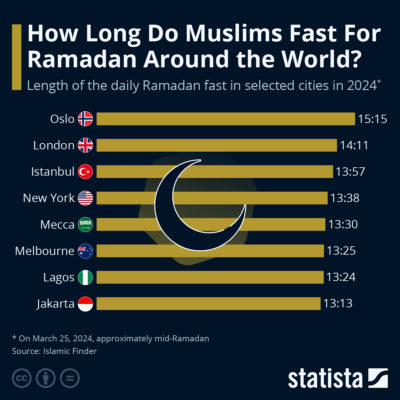Based on the Islamic lunar calendar, the dates for Ramadan move through the year which can result in significantly different daily fasting periods depending on where you live. Since there are 12 lunar months superimposed over 12 solar months, Ramadan “moves back” about 11 days per solar year.
Ramadan is determined by the Islamic lunar calendar, which begins with the sighting of the crescent moon. Saudi Arabia and other Muslim-majority countries rely on the testimonies of moon sighters to determine the start of the month. This year, the first day of fasting for the Muslim holy month of Ramadan in Mecca is expected to be Monday, March 11 or Tuesday, March 12, depending on the sighting of the new moon.
Muslims are then required to fast on each of the 29 to 30 days of Ramadan which means abstaining from food, drink, and sexual relations from before the first light of dawn until the setting of the sun.
A pre-dawn meal is common. Breaking fast at sundown is often done with dates and milk, followed by a fuller meal after the evening prayers. In addition to the five daily prayers, an important optional practice is to gather for additional communal prayers after the night prayer each night of the month. This prayer is called Tarawih.
With Ramadan in early March, those living further north have to fast for much longer than their counterparts living closer to the equator or even to those in the Southern hemisphere, which is currently tilted away from the sun.
Statista compiled the chart below (based on data from website islamicfinder.com) to show how Muslims fasting for Ramadan in Oslo be required to fast a considerably longer time than fellow Muslims in Jakarta, Indonesia, for example. Muslims in Melbourne, meanwhile, will have just 13 hours and 25 minutes of daylight, depending on the exact day of the Ramadan month.










